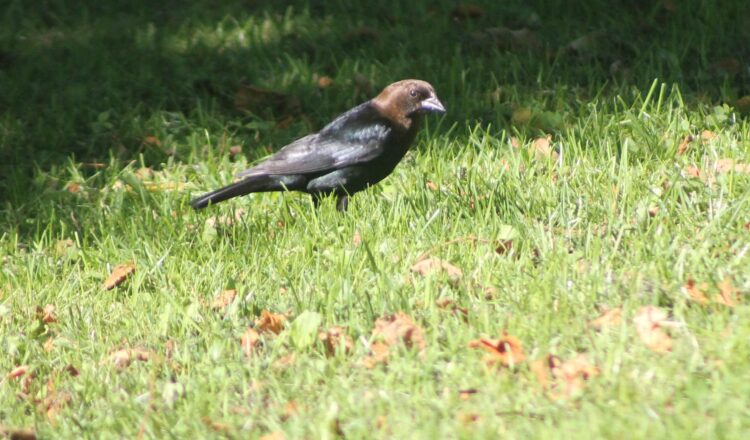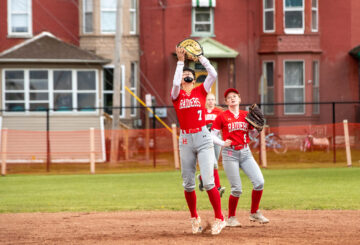By Bob Confer
A lot of people think bad, immoral behavior is unique to Man; only the human race could do the evil things that it does. Animals, on the other hand, are believed to be cute and innocent and free of such flaws.
That’s not always the case. Animals do just as Man sometimes does – they kill for kicks, they cheat on their mates, they pick on the weak, and they even abandon their kids.
It’s that last trait that presents itself in the form of the brown headed cowbird, the ultimate deadbeat parent of the animal kingdom.
Identifying the cowbird
Cowbirds are squat birds — 6 to 8 inches long — that look like short blackbirds. The male has a jet black body with a glossy brown head. The female is among the dullest of local birds, sporting mostly a plain, grayish hue with a lighter throat. They have short, fat bills that look like the seed cracking beaks of finches.
Their songs are rather intriguing for such a plain bird. The male can often be heard making a melodic, almost metallic or watery, gurgling sound as he spreads his wings and tailfeathers to show his physical and sexual dominance. Birds of both sexes will make a high-pitched sound, described as weee-tiiii, as a general call, variations of which will warn of danger or the lack thereof.
Where to find cowbirds
The cowbird is found throughout the Western NY wilds.
They will frequent villages in somewhat low numbers. If you maintain a bird feeder in the summer, you might have had them as guests dining on sunflower seeds.
You are more likely to encounter them in rural communities, especially those with dairy farms, where they can be fairly common, sometimes even abundant.
They get the name of cowbird from their tendency to live near and with livestock. Rather than feeding on the feed of cows as starlings will, cowbirds choose instead to closely follow cows and eat the bugs kicked up by their hooves or frequenting their manure. They will even land on cows’ backs and pick bugs off of them.
Before cows became a part of the Eastern landscape, cowbirds were mostly confined to the central grasslands and associated with herds of bison.
Deadbeat parenting
It’s that affinity for bison, which were incredibly nomadic, that led to the cowbird’s propensity for deadbeat parenting. Ornithologists believe that in order to keep pace with the herds, and not having time to incubate eggs — let alone make a nest — cowbirds used other birds to tend for their young, which is what they still do to this day.
The brown-headed cowbird and its cousin the bronzed cowbird are the only brood parasites on this continent. The female cowbird will find a nest being tended to by another bird and patiently wait for the mother bird to leave for a feeding. Once the bird has left the cowbird deposits up to 5 speckled eggs in the nest and then leaves the scene for good.
Cowbirds are known to do this to over 200 species of birds, with mostly disastrous effects. The unknowing caretaker treats the egg and the hatchlings as her own. Baby cowbirds grow quickly and are typically bigger than the host species. So, the baby cowbird will outcompete the other baby birds for attention and/or food, which will starve the smaller species or cause them to get pushed out of the nest by the larger cowbird.
I’ve seen that many times. The one that sticks in my mind was a chipping sparrow being tailed by a baby that it thought was hers — a juvenile cowbird that absolutely towered over the tiny sparrow. That sparrow that should have been tending to at least 2 babies of her own was instead been feeding a cowbird that was out of the nest. Those baby sparrows died because of that cowbird.
Come fall, newly fledged cowbirds will join up with flocks of other cowbirds and head south for the winter, only to return again the next year and do their thing all over again. (It should be noted that a hardy few do stay here through the winter).
Over the years, it has been frustrating to witness their impact on songbirds — especially catbirds and cardinals — as they have accounted for the deaths of thousands of birds.
But, there is some hope in sight.
The most recent edition of the New York State breeding bird atlas found cowbird populations down 7% between 1985 and 2005, continuing a downward trend that began in the mid-1960s as more family farms (and their token small flocks of cattle) were replaced by grain fields or forests.
If the population trend continues, maybe someday soon some of our more attractive local songbirds will have a chance to raise their own young and reverse their own population declines.







